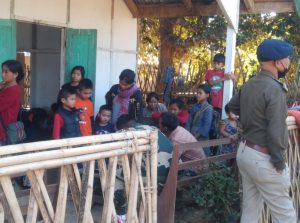Since November last year, over 200 Kuki Chin people have fled their homes in Bangladesh’s Chittagong Hill Tracts to take shelter in the Indian state of Mizoram. The Kuki Chin have ethnic ties with the Mizos in India and were fleeing military operations by the Bangladesh security forces in the restive CHT.
The objective of the military operations was to prevent the CHT from turning into a hotbed of Islamist terror. The CHT has witnessed unrest and armed conflict intermittently for the past many decades. Bangladesh’s security establishment is now concerned over the emergence and spread of a new terror organization, Jamaa’tul Ansar Fil Hindal Sharqiya (JAFHS), which has been striking alliances with local outfits.
According to sources in Bangladesh, JAFHS was founded in 2019, but the spadework for setting it up began two years earlier. “The genesis of the outfit has been traced to a series of meetings at a jail in Dhaka among arrested functionaries of Ansarullah Bangla Team (ABT), Neo JMB (Jamaatul Mujahideen Bangladesh) and Harkat-ul-Jihad-al-Islami (HuJI). Among other decisions, the members of these terror groups decided to join hands to form the JAFHS,” the sources claimed.
According to Bangladesh’s Counter Terrorism and Transnational Crime Unit, Shakir Bin Wali and Shamin Mahfuz were among the masterminds who had organized the meetings in the jail. Mahfuz had been arrested earlier in 2014 for being involved in JMB activities,
The sources disclosed that JAFHS used videos of atrocities on Muslims in India and Rohingya in Myanmar to recruit cadres from Comilla, Sylhet, and Dhaka over the last couple of years. They were told to undergo hijrat (to migrate for the sake of religion) to Bandarban in the CHT, where they underwent training and indoctrination.
Close on the heels of these developments, the Rapid Action Battalion (RAB) received information about 52 persons who were missing from different parts of Bangladesh. The breakthrough came in October last year with the arrest of seven youths from Comilla and other parts of the country, who were also headed to Bandarban for training by the JAFHS.
“It was at this juncture that Kuki Chin National Front (KCNF), which has a support base among some tribal communities in CHT, came under suspicion of RAB for assisting the JAFHS in the training module. The security agencies had gathered evidence of the efforts made by Mahfuz to contact some members of KCNF through social media,” a senior journalist in Chittagong told The Diplomat on condition of anonymity.
Subsequently, “a decision was taken to launch operations in October targeting the JAFHS and KCNF.”
“Leaflets were dropped from helicopters on some villages in CHT by the armed forces requesting information about the training module and specifying the goal of the operation against the terrorists,” the Chittagong journalist said, adding that “it is not known if KCNF responded to the appeal.”
On January 30, Newslink, an English daily published in Mizoram, came out with the translation of the leaflet, originally printed in Bengali.
“This operation is not against any community or tribal groups. Rather, this mission is aimed at the terrorists who have taken shelter in CHT from plain lands. BDSFs [Bangladesh security forces] are well aware of those people who have indulged the terrorists by sheltering them. If they do not hand over the terrorists to BDSFs in a peaceful manner, they will have to face dire consequences. The terrorists who have come from the plains to the CHT are hereby asked to surrender by 1800 hours on 12th Oct 2022,” the leaflet issued by the Bangladesh security forces said.
In the leaflet, the security forces announced a reward of 100,000 Bangladeshi taka ($930 approximately) for information on the terrorists. Four mobile phone numbers were also provided for people to contact if they have information on the terrorists.
Since November, many batches of asylum seekers from the Kuki Chin communities in Bangladesh, including the Bawm, entered India at Lawngtlai in Mizoram.
The Mizoram government has since sanctioned a rehabilitation package of 3 million Indian rupees ($36,000 approximately) for 388 asylum seekers lodged at five border villages.
The KCNF and its armed wing, the Kuki Chin National Army (KCNA), have denied links with Islamist groups. In posts on Facebook, they described the operations by the Bangladesh army in the CHT as “drama” and cautioned journalists to refrain from publishing fake news on the outfit.
The KCNF has been demanding a separate state within Bangladesh for protecting the rights and culture of the Kuki Chin people as a safeguard against underdevelopment and the increasing cases of land-grabbing in the hills. In 2009, research conducted by the Human Development Research Center for UNDP revealed that about 62 percent of households in the region were living below the absolute poverty line measured in terms of the direct calorie intake (DCI) method.
So far, the Bangladesh government has not engaged in dialogue with KCNF to address its grievances.
Sources pointed out that the army has clung to its demand that KCNF must provide information on the key functionaries of JAFHS, some of whom are believed to have relocated from the CHT to other parts of Bangladesh.
The Bangladesh government’s efforts to root out extremism in the CHT can be understood in the backdrop of increasing radicalism among some sections of the country. Two years ago, a massive crackdown was launched against Hefazat-e-Islam, but the undercurrents are believed to be strong and attempts are on by some groups to float new extremist organizations.

































